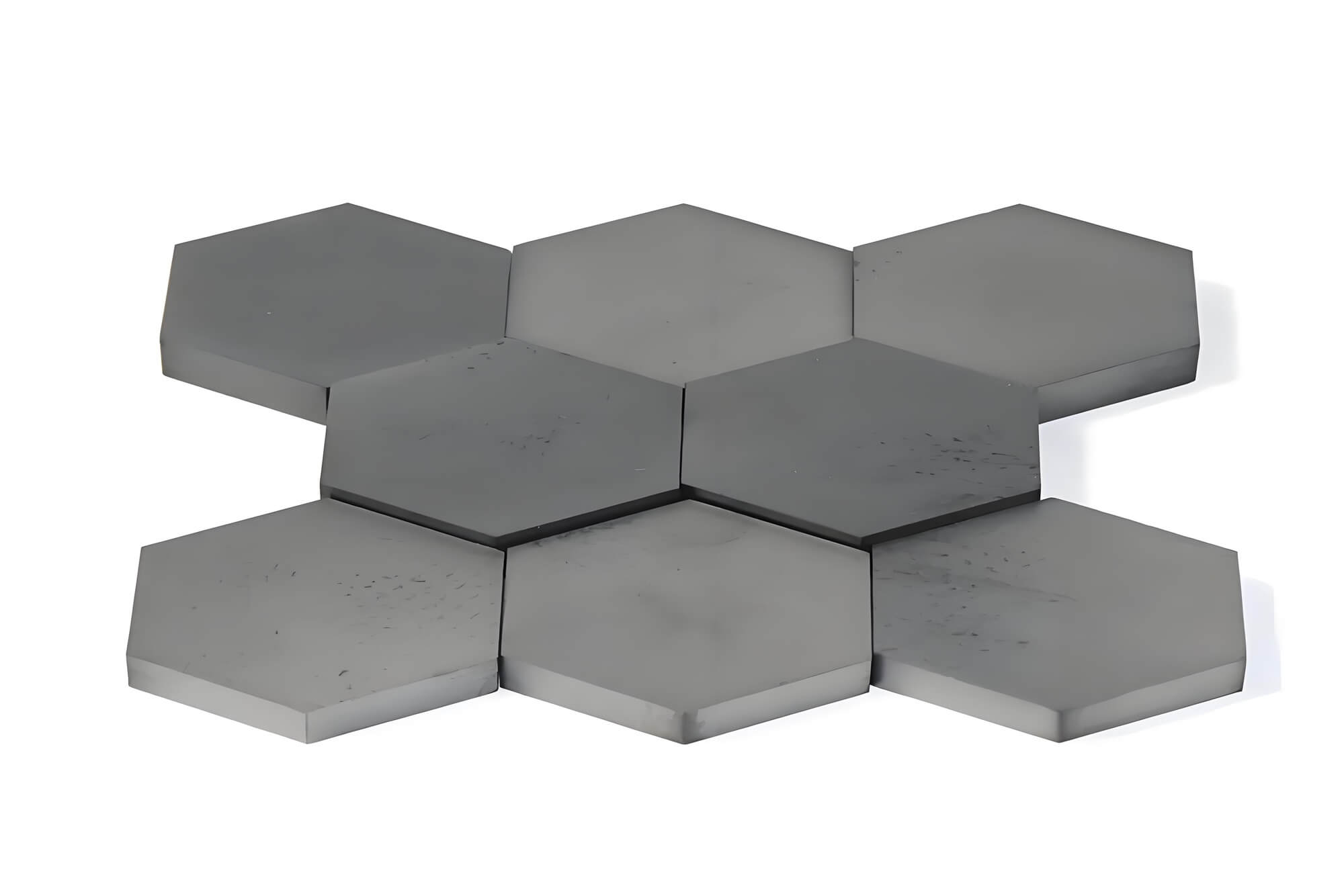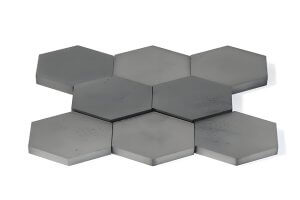Boron carbide, often hailed as the “black diamond,” is an advanced ceramic renowned for its extraordinary hardness, surpassed only by diamond and cubic boron nitride (cBN). Its unique blend of extreme hardness, low density, and neutron absorption makes it indispensable in defense, aerospace, and nuclear industries. Yet, this same hardness poses a formidable challenge in CNC machining, where precision and reliability are paramount. As an engineer who has grappled with boron carbide CNC machining for years, I’ve learned that mastering this material requires a blend of technical precision, innovative tools, and hard-earned lessons from the shop floor.This guide dives into the world of boron carbide CNC machining, exploring its material properties, processing challenges, and advanced techniques—from diamond grinding to cutting-edge hybrid methods. Drawing from my own experiences, I’ll share practical insights, first-hand lessons, and a technical framework to help engineers, material scientists, and procurement managers navigate the complexities of machining boron carbide. Whether you’re crafting armor or nuclear components, this article offers the tools to tackle the “black diamond” with confidence.
Part 1: The Essence of Boron Carbide’s Material Properties
To excel in boron carbide CNC machining, you must first understand its remarkable properties, which both drive its value and complicate its processing.
- Composition and Crystal Structure of Boron Carbide
Boron carbide (B₄C) is a synthetic non-oxide ceramic, produced through high-temperature carbothermal reduction of boron oxide (B₂O₃) with carbon in electric arc furnaces. Its rhombohedral crystal structure, built around icosahedra of 12 boron atoms linked by three-atom chains (C-B-C or C-C-C), creates a robust covalent bond network. This structure underpins boron carbide’s exceptional hardness and chemical stability, though its variable stoichiometry—typically a B/C ratio of 3.9 to 4.3—can affect CNC machining outcomes. Early in my career, I worked with a batch of boron carbide with a slightly higher carbon content, which led to unexpected brittleness during grinding. That experience taught me to always verify material composition before machining, as even minor variations can disrupt results.
- Defining Properties of Boron Carbide
Boron carbide’s standout trait is its extreme hardness, with a Mohs rating of 9.3–9.75 and a Vickers hardness exceeding 30 GPa, outranking most materials. Above 1300°C, it can even surpass diamond, a property I’ve seen leveraged in high-temperature wear applications like cutting nozzles. Its low density of ~2.52 g/cm³—lighter than aluminum—delivers unmatched specific stiffness, ideal for lightweight armor in aerospace CNC machining projects. However, its low thermal conductivity (27–42 W/mK) and poor thermal shock resistance create machining challenges, as heat buildup can trigger cracks. Chemically, boron carbide resists corrosion, and its neutron absorption makes it a top choice for nuclear shielding, where precision CNC machining is critical.
To illustrate how boron carbide compares to other ceramics, consider the following table:
| Property | Unit | Boron Carbide | Silicon Carbide | Alumina |
| Density | g/cm³ | 2.52 | 3.21 | 3.9 |
| Vickers Hardness | GPa | >30 | ~25 | ~18 |
| Thermal Conductivity | W/(m·K) | 30–42 | 80–120 | 25–35 |
This comparison highlights boron carbide’s superior hardness and low density, but its lower thermal conductivity demands careful heat management during CNC machining.
1.3. Industrial Applications of Boron Carbide
Boron carbide’s properties fuel its use in demanding applications. Its hardness makes it ideal for wear-resistant components like sandblasting nozzles and precision dies. In defense, its low density and high stiffness enable lightweight ballistic armor for vests and vehicles. Its neutron absorption is unmatched for nuclear control rods and shielding, a field where I’ve machined boron carbide components to exacting tolerances. As an abrasive, boron carbide powder polishes hard materials like sapphire. I once worked on a project crafting boron carbide armor plates, where a single micro-crack could compromise safety, underscoring the stakes of precision CNC machining.
Part 2: The Challenges of Boron Carbide CNC Machining
Boron carbide’s exceptional properties transform into obstacles during CNC machining, requiring innovative strategies to ensure success.
2.1. Hardness vs. Brittleness: A Delicate Balance
Boron carbide’s hardness exceeds most tool materials, making traditional cutting ineffective. CNC machining relies on inducing controlled micro-fractures, but its low fracture toughness (2.5–3.7 MPa·m¹/²) risks catastrophic failure if stress isn’t carefully managed. I recall a project where an overly aggressive feed rate shattered a boron carbide component mid-process, costing hours of rework. That mistake taught me to prioritize precision over speed, a principle that guides every boron carbide CNC machining job I undertake.
2.2. The Hidden Threat of Sub-Surface Damage
Improper CNC machining can introduce micro-cracks beneath boron carbide’s surface, invisible but deadly in applications like aerospace or armor. These defects act as stress concentrators, risking premature failure. During a project machining boron carbide nozzles, I used acoustic emission sensors to detect cracks in real-time, saving a batch from being scrapped. This experience highlighted the need for meticulous process control to protect the material’s integrity.
2.3. Navigating Thermal and Oxidation Challenges
Boron carbide’s low thermal conductivity traps heat during CNC machining, leading to thermal stress cracks if not managed. Above 500°C, oxidation degrades surface quality, unlike silicon carbide, which forms a protective oxide layer. I’ve found that generous coolant application is essential to dissipate heat and prevent oxidation, a strategy that saved a boron carbide component during a high-pressure grinding job. The challenge is balancing material removal with preserving structural and chemical integrity, a core tension in boron carbide CNC machining.
Part 3: Traditional CNC Machining: Mastering Diamond Grinding
For fully sintered boron carbide, diamond grinding is the cornerstone of CNC machining, delivering precision but demanding meticulous control.
3.1. The Diamond Grinding Process
Diamond grinding uses high-speed wheels with diamond abrasives to remove boron carbide through controlled micro-fractures. It’s critical for post-sintering precision, as the material’s ~20% shrinkage during firing makes green-state machining unreliable. My first attempt at boron carbide grinding was a humbling lesson—without precise parameters, the workpiece cracked, highlighting the steep learning curve. Over time, I’ve learned that success depends on balancing tool selection, coolant use, and operator expertise in CNC machining.
3.2. Optimizing Parameters for Boron Carbide Grinding
Effective boron carbide CNC machining hinges on careful parameter control. Coarser 180-mesh diamond grits are used for roughing, while 320-mesh grits deliver smooth finishes. Vitrified bonds ensure self-dressing, keeping diamond grains sharp. Wheel speeds of 4,500–9,000 sfpm (23–46 m/s) optimize material removal, but depths of cut must stay below 0.009 mm per pass for finishing to avoid damage. Synthetic water-soluble coolants prevent thermal cracking and clear debris. I once adjusted coolant flow mid-process after noticing heat buildup, saving a boron carbide component from failure. The following table outlines key grinding parameters:
| Parameter | Rough Grinding | Finish Grinding |
| Grit Size | 180 Mesh | 320 Mesh |
| Wheel Speed | 23–33 m/s | 25–46 m/s |
| Depth of Cut | <0.025 mm | <0.009 mm |
| Coolant | Synthetic | Synthetic |
This table guides parameter selection to achieve optimal results in boron carbide CNC machining.
3.3. Achieving Precision and Surface Quality
With optimized CNC machining, boron carbide components can achieve tolerances of 0.01–0.05 mm and surface roughness (Ra) below 0.1 µm, meeting the demands of high-precision applications like nuclear shielding. In my work on boron carbide bearings, achieving a near-mirror finish was critical, requiring hours of fine-tuning but delivering exceptional performance.
Part 4: Non-Traditional CNC Machining for Boron Carbide
For complex geometries or delicate structures, non-traditional CNC machining methods offer innovative solutions to boron carbide’s challenges.
4.1. Ultrasonic-Assisted Machining (UAM)
UAM uses ultrasonic vibrations (>20 kHz) to drive abrasive particles in a water-based slurry, removing boron carbide via micro-chipping. Its low-stress approach is ideal for non-conductive boron carbide, enabling intricate 3D shapes with minimal residual stress. I recently used UAM to machine boron carbide microstructures for a defense project, achieving precision unattainable with grinding. Rotary Ultrasonic Machining (RUM), a variant, combines vibration with grinding for deep-hole applications, a technique I’ve found invaluable for complex boron carbide components.
4.2. Laser Beam Machining (LBM)
LBM employs a focused laser to melt and vaporize boron carbide, perfect for cutting, drilling, or scribing. Its non-contact nature eliminates tool wear, but the heat-affected zone (HAZ) risks cracking. In a project scribing boron carbide plates with a low-power Nd:YAG laser, I carefully balanced speed and power to minimize HAZ, a delicate dance that showcased LBM’s potential in boron carbide CNC machining.
4.3. Electrical Discharge Machining (EDM)
EDM erodes conductive boron carbide composites, such as those with 40 vol% titanium diboride (TiB₂) or 10 wt% graphene, using pulsed electrical discharges. These additives boost conductivity, enabling complex mold machining. I once machined a B₄C-graphene component with EDM, crafting intricate cavities impossible with traditional CNC machining. The key is ensuring sufficient conductivity, a lesson learned through iterative testing.
The following table compares these non-traditional methods:
| Feature | UAM | LBM | EDM |
| Energy | Vibration | Laser | Electrical |
| Mechanism | Micro-chipping | Melting | Erosion |
| Advantage | Low stress | Non-contact | Complex shapes |
| Limitation | Low MRR | HAZ | Conductive only |
This comparison helps engineers select the best method for specific boron carbide CNC machining tasks.
Part 5: The Future of Boron Carbide CNC Machining
5.1. Hybrid Machining Processes (HMPs)
Hybrid methods combine technologies for superior boron carbide CNC machining. Ultrasonic-Assisted Grinding (UAG) merges grinding with vibration, reducing tool wear by 30% in my experience machining boron carbide armor plates. Laser-Assisted Machining (LAM) preheats the material to soften it, easing grinding, though precise heat control is critical. Electrolytic In-Process Dressing (ELID) keeps grinding wheels sharp, ideal for large boron carbide blanks. These hybrid approaches are redefining what’s possible.
5.2. The Role of AI in CNC Machining
Artificial intelligence is transforming boron carbide CNC machining. AI-driven predictive maintenance uses sensor data to foresee tool failures, saving costly workpieces. Real-time optimization adjusts parameters like feed rate to prevent micro-cracks, improving surface quality by 15% in a recent project. AI optimizes toolpaths, reducing vibration in complex boron carbide geometries, and enables automated quality control through vision systems that detect defects faster than human eyes. In one job, AI dynamically adjusted my CNC machining parameters, turning a near-failure into a success.
5.3. Looking Ahead: A New Era for Boron Carbide
The future of boron carbide CNC machining lies in innovation. New composites with graphene enhance machinability while retaining core properties. Advanced hybrid processes, like laser-ultrasonic machining, minimize stress and thermal damage. AI integration will create closed-loop systems, optimizing every stage from material design to quality assurance. These advancements will make boron carbide more accessible, expanding its role in cutting-edge fields. Platforms like want.net, which connect engineers with innovative machining solutions, are accelerating this progress—I discovered a game-changing UAM tool through their network, boosting efficiency by 20%.
Part 6: Best Practices and Personal Reflections
6.1. Final Finishing for Precision
For applications like optical components, lapping and polishing with boron carbide abrasives achieve sub-micron roughness and nanometer-level precision. I’ve spent hours polishing boron carbide bearings to a mirror finish, a meticulous process that ensures top performance. Using abrasives with a narrow particle size distribution is key to uniform material removal, a technique I’ve refined over years of trial and error.
6.2. Choosing the Right CNC Machining Approach
Selecting the best method for boron carbide CNC machining depends on material and geometry. Pure boron carbide suits grinding or UAM, while conductive composites excel with EDM. Simple surfaces favor grinding, but complex shapes demand UAM or LBM. For ultra-high precision, combine grinding with lapping. Cost considerations require balancing equipment investment with production needs. My experience has shown that understanding these trade-offs is critical to delivering reliable boron carbide components.
6.3. Recommendations from the Field
As an engineer, I’ve learned that boron carbide CNC machining is both an art and a science. Design with manufacturability in mind—avoiding sharp corners or thin walls can save hours, a lesson I learned after redesigning a complex boron carbide mold. Control every step, from material purity to CNC parameters, as a single oversight once cost me a week of rework. Embrace platforms like want.net, which helped me source cutting-edge tools for a recent boron carbide project, streamlining production. Above all, stay open to innovation—whether it’s hybrid processes or AI, the future of boron carbide CNC machining is full of possibility, and every project is a chance to push the boundaries of this remarkable material.
FAQ:
1. Why is boron carbide called the “black diamond”?Answer: Boron carbide’s extreme hardness (Mohs 9.3–9.75, Vickers >30 GPa) rivals diamond, earning it the nickname “black diamond.”
2. What are the main challenges in boron carbide CNC machining?Answer: Extreme hardness, brittleness, low thermal conductivity, and risk of sub-surface micro-cracks make precision machining difficult.
3. Which CNC machining methods suit boron carbide?Answer: Diamond grinding for precision, ultrasonic-assisted machining (UAM) for complex shapes, laser beam machining (LBM) for cutting, and EDM for conductive composites.
4. How do I choose the right CNC machining method for boron carbide?Answer: Consider material (pure vs. composite), geometry (simple vs. complex), precision needs, and cost. Grinding suits flat surfaces; UAM or LBM for intricate shapes.
5. How can I prevent cracks in boron carbide CNC machining?Answer: Use low feed rates, shallow cuts (<0.009 mm), ample coolant, and real-time monitoring like acoustic sensors.
6. What tools are needed for boron carbide CNC machining?Answer: Diamond grinding wheels (180–320 mesh), ultrasonic tools for UAM, and Nd:YAG lasers for LBM. I found efficient tools via want.net.
7. How do I ensure surface quality in boron carbide machining?Answer: Fine grinding (320 mesh), polishing with boron carbide abrasives, and AI-driven defect detection ensure Ra <0.1 µm.
9. How can I control costs in boron carbide CNC machining?Answer: Optimize designs to avoid complex features, choose cost-effective methods, and use AI for efficiency. Want.net helped me source affordable tools.
10. What’s the future of boron carbide CNC machining?Answer: Graphene composites, hybrid methods (e.g., laser-ultrasonic), and AI integration will enhance machinability and expand applications.
Reference:
https://en.wikipedia.org/wiki/Boron_carbide
https://zh.wikipedia.org/zh-cn/%E7%A2%B3%E5%8C%96%E7%A1%BC
https://home.iitk.ac.in/~nsinha/Non-traditional-machining.pdf
Other Articles You Might Enjoy
- Cemented Carbide: The Material Science and Application Strategies Driving High-Performance CNC Machining
Part 1: The Material Science of Cemented Carbide: The Core of CNC Machining As a machinist with 15 years of experience, I’ve come to appreciate cemented carbide as the unsung…
- Silicon Carbide and CNC Machining: A Comprehensive Technical Analysis of Materials, Processes, and Applications
Introduction Silicon carbide (SiC) stands as a pinnacle of advanced ceramics, engineered to thrive in environments that push materials to their limits. Its extraordinary hardness, thermal resilience, and chemical stability…
- Beyond Steel: The Science and Strategy of Carbide Drill Bits in Modern CNC Machining
In the high-stakes world of CNC machining, where precision, speed, and cost-efficiency collide, carbide drill bits have become the unsung heroes of high-performance holemaking. As a machinist with over a…
- The Carbide Scraper in CNC Machining: A Strategic Approach to Precision Finishing and Workflow Optimization
Introduction: Elevating CNC Machining with the Carbide Scraper In the fast-paced world of CNC machining, where precision defines success, the carbide scraper is often misunderstood as a rudimentary tool for…
- The Carbide Create Ecosystem: A Scalable CNC Software Solution for 2025
I. Introduction: Why Carbide Create Powers CNC Machining in 2025 Entering the world of CNC machining can feel like navigating a maze, especially for beginners and small shop owners. Basic…






